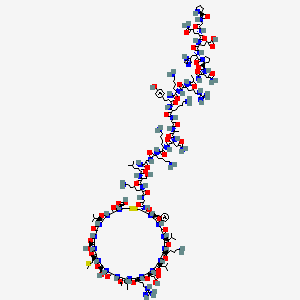



API Suppliers

US DMFs Filed
0

CEP/COS Certifications
0

JDMFs Filed
0
Other Certificates
0
Other Suppliers
0
0

USA (Orange Book)

Europe
0

Canada
0

Australia

South Africa
0
Uploaded Dossiers
0
U.S. Medicaid
0
Annual Reports
0
0


1. Bmn 111
2. Voxzogo
1. Voxzogo
2. Bmn 111
3. Bmn-111
4. Vosoritide [usan:inn]
5. Unii-7se5582q2p
6. 1480724-61-5
7. Gtpl9068
8. 7se5582q2p
| Molecular Weight | 4103 g/mol |
|---|---|
| Molecular Formula | C176H290N56O51S3 |
| XLogP3 | -20.6 |
| Hydrogen Bond Donor Count | 61 |
| Hydrogen Bond Acceptor Count | 64 |
| Rotatable Bond Count | 112 |
| Exact Mass | 4101.1016174 g/mol |
| Monoisotopic Mass | 4100.0982626 g/mol |
| Topological Polar Surface Area | 1820 Ų |
| Heavy Atom Count | 286 |
| Formal Charge | 0 |
| Complexity | 9600 |
| Isotope Atom Count | 0 |
| Defined Atom Stereocenter Count | 32 |
| Undefined Atom Stereocenter Count | 0 |
| Defined Bond Stereocenter Count | 0 |
| Undefined Bond Stereocenter Count | 0 |
| Covalently Bonded Unit Count | 1 |
Vosoritide is indicated for the promotion of linear growth in pediatric patients with achondroplasia who are 5 years of age and older with open epiphyses.
Voxzogo is indicated for the treatment of achondroplasia in patients 2 years of age and older whose epiphyses are not closed. The diagnosis of achondroplasia should be confirmed by appropriate genetic testing.
Vosoritide is an analog of C-type natriuretic peptide that promotes bone growth to combat growth suppression in children with achondroplasia. Urinary cyclic guanosine monophosphate (cGMP) and serum collagen type X marker (CXM) are both elevated following daily therapy with vosoritide and serve as biomarkers for evidence of increased endochondral bone growth, with cGMP indicative of NPR-B binding activity and CXM indicative of bone metabolism. Although relatively well-tolerated, transient episodes of hypotension have been observed in clinical studies. Patients with pre-existing cardiovascular disease and those taking antihypertensive medications were excluded from clinical trials. The risk of hypotension may be reduced by ensuring adequate food and fluid intake prior to the administration of vosoritide. The use of vosoritide in patients with an eGFR <60 mL/min/1.73m2 should also be avoided as there are no data on the influence of renal impairment on its pharmacokinetics.
M05BX
M - Musculo-skeletal system
M05 - Drugs for treatment of bone diseases
M05B - Drugs affecting bone structure and mineralization
M05BX - Other drugs affecting bone structure and mineralization
M05BX07 - Vosoritide
Absorption
In patients receiving daily subcutaneous injections of vosoritide 15 mcg/kg, the mean Cmax ranged from 4.71-7.18 ng/mL and the mean AUC0-t ranged from 161-290 ng-min/mL. The median Tmax following subcutaneous injection was approximately 15 minutes.
Volume of Distribution
The mean apparent volume of distribution following the subcutaneous administration of 15 mcg/kg of vosoritide ranged from 2880 to 3020 mL/kg.
Clearance
The mean apparent clearance following the subcutaneous administration of 15 mcg/kg of vosoritide ranged from 79.4 to 104 mL/min/kg.
As with other therapeutic proteins, vosoritide is likely metabolized via catabolic pathways into smaller peptides and amino acids.
The mean half-life following the subcutaneous administration of 15 mcg/kg of vosoritide ranged from 21.0 to 27.9 minutes.
Achondroplasia is a congenital disease resulting from a missense mutation in the fibroblast growth factor receptor 3 (_FGFR3_) gene, resulting in a gain-of-function that negatively regulates endochondral bone growth. Under normal conditions, _FGFR3_ is expressed during both embryonic and postnatal development, but serves a different role in each. During initial development, FGFR3 signaling promotes proliferation of chondrocytes (i.e. growth), whereas postnatal skeletal growth is actually inhibited by FGFR3 - as a result, the pathologic activation of FGFR3 observed in patients with achondroplasia leads to suppressed pre-pubertal skeletal growth. Vosoritide is an analog of C-type natriuretic peptide (CNP), a signaling molecule that appears primarily responsible for the stimulation of chondrocytes and the growth of long bones. The binding of CNP (or vosoritide) with its corresponding receptor, NPR-B, results in a signaling cascade that ultimately inhibits the MAPK/ERK pathway via inhibition of RAF-1 and stimulates the proliferation and differentiation of chondrocytes. This activity serves to antagonize the downstream signaling resulting from FGFR3 and its resultant effects on bone growth.


